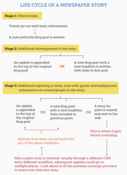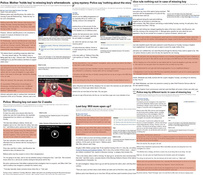
urbansheep@gmail.com
The New, Convoluted Life Cycle Of A Newspaper Story - 10,000 Words - http://www.mediabistro.com/10000wo... (via http://ff.im/OhE63)

|

|
21 ноября 2011 в 20:02
alf
smallq
вприпрыжку с кладбища
earlyadopter
“As Jay Rosen and crew brought up at an SXSW “Future of Context” panel, our news often falls into episodic spurts. We cover stories through the convention of writing “stories” like we would for print. When there’s new information, we add a few sentences to the top of the post to tell the new information, then summarize the rest of the story at the bottom. We basically have the same stories repurposed over and over again with a few snippets of new information at the top. See the image below for an example — the highlighted portions are the redundant parts of an ongoing story for six Seattle Times articles.
Episodic storytelling is based on the model we used for telling stories when print papers came out once/day and that was our only chance to tell the full story and the only medium for getting the full context about a story. We don’t have to do that on the web, but we won’t change how we tell stories on the web while that print medium still exists. So we have to find a happy balance between the two, while thinking ahead to how that model might look in a future when print isn’t the same print is today. Easier said than done, right?” #будущее_мидий - × × ×
(К нашему длинному распределённому разговору с @zverok, @anykeen и @mindszenty о том, как строить, собирать, оформлять и публиковать длинные материалы, которые в процессе жизненного цикла дополняются и обновляются, поэтому нужно давать что-то новое-компактное тем, кто читает впервые, и указывать на обновления тем, кто читал историю раньше, и пришёл посмотреть, что изменилось.) - × × ×
© 2015 FriendFeed (and Clio archiver)